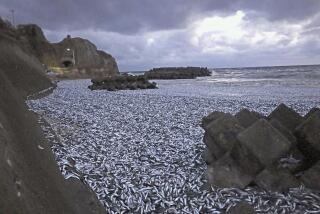Japanese boat first confirmed tsunami debris in California
A 20-foot boat that washed ashore earlier this month in Northern California has been confirmed as the first debris from the 2011 Japanese tsunami to reach the state.
The National Oceanic and Atmospheric Administration, working with the Japanese Consulate in San Francisco, was able to confirm Thursday that the boat found April 7 in Crescent City was from Rikuzentakata, Japan, said agency spokeswoman Keeley Belva.
Local authorities reported the boat to NOAA after it was discovered by beachgoers, Belva said. It is the 27th confirmed piece of debris found on the U.S. coast, in British Columbia and at sea, she said, out of nearly 1,700 possible debris items that have been reported to the agency.
Though official confirmation came Thursday, Facebook helped make the connection earlier.
After characters on the side of the barnacle-covered boat were roughly translated to say “Takata High School” -- a school in Rikuzentakata -- a Humboldt State University professor tracked down the Japanese city’s Facebook page and posted photos of the skiff, the Times-Standard reported.
A teacher was quickly able to confirm the boat belonged to the school, which the newspaper said lost students and instructors and was destroyed by the tsunami.
A Rikuzentakata spokeswoman told the Times-Standard the city was “giddy” to hear the boat had been found.
“Just to know it made it, just to know it made it across the Pacific, that’s just one of these things in life that no one is prepared for -- but in the best possible way,” Amya Miller said. “That something made it across the ocean is beautiful. It’s absolutely beautiful.”
The Japanese government guesses the magnitude 9 earthquake and subsequent tsunami -- which killed thousands and devastated the northern part of the country -- swept somewhere around 5 million tons of debris into the Pacific Ocean, NOAA said. Although 70% of that was thought to have sunk quickly, there is an estimated 1.5 million tons still spread across the ocean.
Some pieces have reached the U.S. coast, including a 65-foot-long dock found in Central Oregon last year. But Belva said it was hard to guess what could turn up in the future.
“We think that it will probably trickle through as things go on,” she said. “It’s hard to say when anything will show up exactly -- it depends on what it is, if something has broken down, weather patterns and currents. It really is challenging [to predict].”
ALSO:
Burglary suspect arrested after fleeing to Venice roof
No charges yet for UCLA water polo player accused of rape
He’s no Goldilocks: Sex offender takes shower at random house, police say
Twitter: @katemather | Google+
kate.mather@latimes.com
More to Read
Start your day right
Sign up for Essential California for news, features and recommendations from the L.A. Times and beyond in your inbox six days a week.
You may occasionally receive promotional content from the Los Angeles Times.







